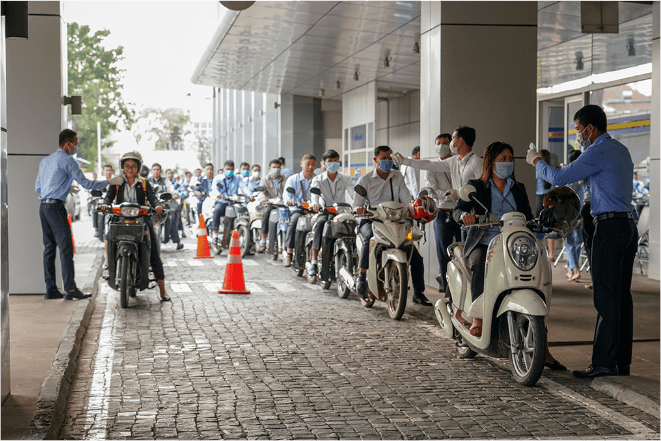
With no end in sight for the pandemic, the Association of Southeast Asian Nations (ASEAN) is scaling up efforts to protect public health from the coronavirus disease (COVID-19) and improve its collective response. No cure or vaccine has yet been developed, infections continue to rise worldwide, and more than a million people have died. Fatalities in ASEAN are about 2% of the global total with most countries in the region having been able to control the spread of the virus.
ASEAN is planning to launch several initiatives, which include creating an ASEAN Center for Public Health Emergencies and Emerging Diseases, said Ferdinal Moreno Fernando, assistant director and head of the health division of the ASEAN Human Development Directorate. It is conducting a study with Japan on establishing the center by 2021. It is establishing a COVID-19 regional fund with contributions from trust funds within ASEAN and dialogue partners and a regional reserve for medical supplies (including personal protective equipment or PPE) with commitments from volunteer countries. It is also looking at best practices within and outside ASEAN, such as the Greater Mekong Subregion and its development partners.
These initiatives are critical in preventing a new wave of infections as countries in the region reopen their economies.
Regional health mechanisms
Speaking at a webinar organized by the Asian Development Bank (ADB) on 15 October 2020, Fernando said ASEAN started to mobilize regional actions to support national efforts against COVID-19 as early as 3 January upon receiving reports of a disease outbreak from the People’s Republic of China (PRC).
ASEAN, which groups 10 countries in Southeast Asia, activated regional mechanisms that were already in place to fill data and information gaps as well as share knowledge and response practices and lessons in a timely manner. These include the ASEAN Emergency Operations Centre Network for public health emergencies (ASEAN EOC Network), which provided daily updates and information on prevention, detection, and response measures to member states and development partners, particularly the PRC, Republic of Korea, and Japan; ASEAN BioDioaspora Regional Virtual Centre (ABVC) for big data analytics and visualization, which produced risk assessment reports; the ASEAN plus Three Field Epidemiology Training Network (APT FETN) strengthened public health and animal health epidemiology capacity; and the Regional Public Health Laboratory Network, which facilitated exchanges on laboratory readiness and response and disease surveillance actions.
Fernando said the ASEAN-wide collective response to COVID-19 under its coordinating council working group on public health emergencies also covers standard operating procedures for public health emergencies, the ASEAN Comprehensive Recovery Framework, travel corridor arrangement, Health Sector COVID-19 Response, and actions for labor, youth, social welfare, education, and information sectors. In addition, the group is strengthening cooperation on vaccine security under the ASEAN Vaccine Security and Self-Reliance initiative.
Aside from addressing the health crisis, it has also taken a whole-of-ASEAN Community approach to the economic and social impacts of COVID-19. Fernando said COVID-19 has made health systems and socioeconomic conditions in the region more fragile.
Lessons from the Greater Mekong Subregion
Five of the six countries that make up the Greater Mekong Subregion (GMS) are ASEAN members, and most of them have been able to keep COVID-19 infection and death rates low.
Among the factors that has helped curbed the spread of the virus is strong health cooperation, said Rikard Elfving, a senior social sector specialist at ADB, at the webinar.
For years, the subregion has been strengthening health systems and their capacity to prevent, detect, and respond to public health threats. The GMS is a hotspot for communicable diseases, such as drug-resistant malaria, because of the increasing flow of people and goods across borders.
Elfving, who is working on ADB’s health portfolio in the GMS, said Mekong countries understand that the cost of inaction is much higher than investing in health. ADB has been working with GMS countries to enhance health security. An ADB-supported project that allows funds to be quickly reprogrammed to address major health emergencies proved useful in helping the countries purchase PPEs and other medical equipment and implement measures for disease control, such as the deployment of thermal scanners at points of entry.
Possible areas of collaboration
Elfving identified possible areas for collaboration in the GMS and ASEAN:
- A project on migration and health that will support points of entry and health facilities for sanitation and hygiene, testing, and isolation and quarantine for facilitating safe movement of people;
- Digital health solutions that facilitate the movement of people across the region in the new normal and that improve border health services;
- Improving the response to all hazards and emerging health threats, including pandemics, and strengthening public health systems and access to healthcare;
- Addressing the nexus between animal and human health using evidence-based practices and new approaches for improved prevention and response;
- Building core capacity for ensuring timely access to a safe and effective COVID-19 vaccine. The GMS Program can assess the needs and gaps for vaccines and promote regional mechanisms for pooled procurement to achieve timely access and have better negotiating power with major manufacturers;
- Exploring intraregional capacity building, learning exchanges, and skills transfer in common areas of interest, especially medicine, nursing, public health, field epidemiology, and traditional medicines;
- Strengthening the link between GMS investments for Cambodia, Lao People’s Democratic Republic, Myanmar, and Viet Nam (CLMV) and the initiative on ASEAN integration that seeks to bridge the gap between CLMV and other member states. The initiative helps ASEAN’s newer Member States implement ASEAN commitments and agreements;
- Strengthening cross-sectoral collaboration and addressing health impacts in other sectors, such as road safety, air pollution, and water- and vector-borne diseases.
- A study on 2 decades of investment in regional health security, which includes ADB–ASEAN SARS/H1N1 collaboration; and
- An action plan on health (GMS/ASEAN/ADB). Institutionalize health collaboration in areas where a partnership brings value and benefits to the region.
This article was first published by BIMP-EAGA on 23 October 2020.

